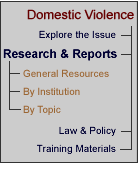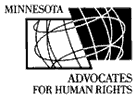|
|
|
By Institution Integration
of the Human Rights of Women and the Gender Perspective: Cultural
Practices in the Family that Are Violence Towards Women, Report of the Special Rapporteur on violence against women, its causes
and consequences, Ms. Radhika Coomaraswamy, submitted in accordance
with Commission on Human Rights resolution 2001/49 (E/CN.4/2002/83),
31 January 2002. [Available in PDF and Word, 39 pages]. The addendum
to the Report of the Special Rapporteur (E/CN.4/2002/83/Add.1), 28
January 2002, contains country information on Republic of Moldova,
the Russian Federation, and Uzbekistan. [Available in PDF and Word,
41 pages]. Statement
of the Special Rapporteur to the Commission on Human Rights on 10
April 2002 . First
World Report on Violence and Health, World Health Organization, 2002. [PDF, 372 pages; 54-page summary in
PDF, press releases and fact sheets available]. Integration
of the Human Rights of Women and the Gender Perspective: Violence
Against Women, Report of the Special Rapporteur on violence against women, its causes
and consequences, Ms. Radhika Coomaraswamy, on violence against women
perpetrated and/or condoned by the State during times of armed conflict
(1997-2000), submitted in accordance with Commission on Human Rights
resolution 2000/45 (E/CN.4/2001/73), 23 January 2001. [Available in
PDF and Word, 45 pages]. Review
of Reports, Studies and Other Documentation for the Preparatory Committee
and the World Conference, Note by the Secretary-General, transmission of contribution by Special
Rapporteur Radhika Coomaraswamy to the World Conference Against Racism,
Racial Discrimination, Xenophobia and Related Intolerance on the subject
of race, gender and violence against women (A/CONF.189/PC.3/5), 27
July 2001. [Available in PDF and Word, 64 pages]. [Building on Achievements: Women’s Human Rights Five Years After
Beijing], Office of the United Nations High Commissioner
for Human Rights, May 2000. Integration
of the Human Rights of Women and the Gender Perspective: Violence
Against Women, Report of the Special Rapporteur on violence against women, its causes
and consequences, Ms. Radhika Coomaraswamy, on trafficking in women,
women’s migration and violence against women, submitted in accordance
with Commission on Human Rights resolution 1997/44 (E/CN.4/2000/68),
29 February 2000. [Available in PDF and Word, 38 pages]. Economic
and social policy and its impact on violence against women
(E/CN.4/2000/68/Add.5), 24 February 2000. [Available in PDF and Word,
20 pages]. Integration
of the Human Rights of Women and the Gender Perspective: Policies
and Practices that Impact Women’s Reproductive Rights
and Contribute to, Cause or Constitute Violence Against Women, Addendum to Report of the Special Rapporteur on violence against women,
its causes and consequences, Ms. Radhika Coomaraswamy, in accordance
with Commission on Human Rights resolution 1997/44 (E/CN.4/1999/68/Add.4),
21 January 1999. Further Promotion and Encouragement of Human Rights and Fundamental Freedoms, Including the Question of the Programme and Methods of Work of the Commission: Alternative Approaches and Ways and Means Within the United Nations System for Improving the Effective Enjoyment of Human Rights and Fundamental Freedoms, Report of the Special Rapporteur on violence against women, its causes and consequences, Ms. Radhika Coomaraswamy, submitted in accordance with Commission resolution 1997/44 (E/CN.4/1998/54), 26 January 1998. Further Promotion and Encouragement of Human Rights and Fundamental Freedoms, Including the Question of the Programme and Methods of the Work of the Commission: Alternative Approaches and Ways and Means Within the United Nations System for Improving the Effective Enjoyment of Human Rights and Fundamental Freedomes, Report of the Special Rapporteur on violence against women, its causes and consequences, Ms. Radhika Coomaraswamy (E/CN.4/1997/47), 12 February 1997. Further
Promotion and Encouragement of Human Rights and Fundamental Freedoms, Report of the Special Rapporteur on violence against women, its causes
and consequences, Ms. Radhika Coomaraswamy, submitted in accordance
with Commission on Human Rights resolution 1995/85 (United Nations
E/CN.4/1996/53), 6 February 1996. Domestic
Violence Against Women and Girls, UNICEF, Innocenti Digest, vol. 6, 2000. [PDF, 30 pages]. Gender Dimensions
of Racial Discrimination, Office of the High Commissioner for Human Rights. [PDF, 31 pages]. Gender
and Racial Discrimination: Report of the Expert Group Meeting, United
Nations Division for the Advancement of Women, Office of the High Commissioner
for Human Rights, United Nations Development Fund for Women, 21-24
November 2000, Zagreb, Croatia. United Nations’ reports on issues concerning women’s rights that are issued in the future may be located at the Office of the High Commissioner for Human Rights website, Documents on Women’s Rights . This site includes documents produced by the Commission on Human Rights and the Commission on the Status of Women and the Economic and Social Council, many of which are listed in this compilation. Note that a reference number may be necessary to locate a specific document. Ending
Domestic Violence: Action and Measures, Proceedings of the Forum at Bucharest, Romania, 26-28 November 1998
(EG/BUC (99) 1), 2000. Violence
against Women in Europe: Report
(Doc. 8667), Parliamentary Assembly of the Council of Europe, Committee
on Equal Opportunities for Women and Men, 15 March 2000. Steering
Committee for Equality Between Women and Men: Summary of the Plan
of Action to Combat Violence Against Women, Shelia Henderson, (EG-S-VL (98)), June 1998. Men
and Violence Against Women, Proceedings (EG/SEM/VIO (99) 21), 5 April 2000. [PDF, 175 pages]. The Protection
of Women against Violence, Recommendation Rec(2002)5 of the Committee of Ministers to member States
on the protection of women against violence, adopted on 30 April 2002,
and Explanatory Memorandum. [PDF, 52 pages]. Although many of these may not be available on-line, the Council of Europe provides a list of its documents on equality between men and women. Documentation centers, from which these documents may be obtained, are located in each member country. Additional information about the actions taken by the Council of Europe to combat violence against women are available through the Council’s October 2002 Fact Sheet on violence against women. Report
from the Commission to the Council, The European Parliament, The
Economic and Social Committee and the Committee of the Regions:
Annual Report on Equal Opportunities for Women and Men in the European
Union 2000, Commission of the European Communities, 2 April 2001. [PDF, 39 pages]. Report
from the Commission to the European Parliament and the Council on
the Daphne Programme (2000-2003): January 2002, Commission of the European Communities, (SEC(2002) 338), 8 April 2002.
[PDF, 26 pages]. DAPHNE:
External Evaluators’ report on the
1999 Initiative, November 2001. [PDF, 27 pages]. The
DAPHNE Initiative (1997-1999): Overview and External Evaluators’ report of the 1998 Initiative, March 2001. [PDF, 28 pages]. Breaking
the Silence, European Communities, 2000. [PDF, 13 pages]. Special
Issue: Domestic violence against Women,
Women of Europe Newsletter No. 92. [PDF, 4 pages]. Unveiling
the hidden data on domestic violence in the European Union,
1998-1999. Organization for Security and Cooperation in Europe (OSCE) Final
Report,
OSCE Supplementary Implementation Meeting: Gender Issues, Vienna, 14-15
June 1999. [PDF, 19 pages]. Briefing:
Domestic Violence in the OSCE Region,
7 September 2001. [Testimony available in PDF and HTML]. Gender
Action Plan: June 2000 – June 2001,
Office for Democratic Institutions and Human Rights (ODIHR), September
2001. Domestic Violence: Explore the Issue | Domestic Violence: Research and Reports Home | Domestic Violence: Law and Policy | Domestic Violence: Training |
| Home | Contact | Feedback | Disclaimer |

